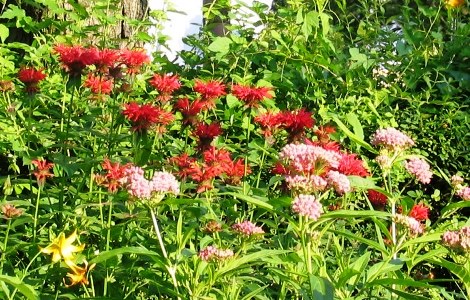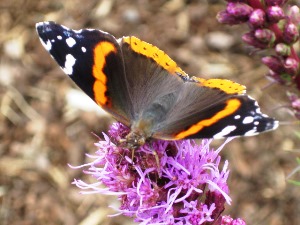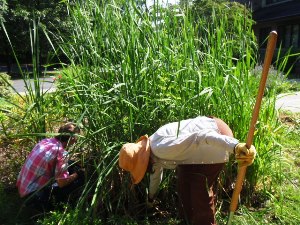
Native plant gardens are popping up everywhere: in private yards and public parks, outside office buildings and airports, around schools and libraries, and even in the planting beds in shopping center parking lots. Why have native plant gardens become so popular? Native plant gardens...
- Are good for the environment – they don’t need pesticides and fertilizers, which wash into local streams when it rains.
- Attract colorful birds and butterflies.
- Save you time – they don’t need much attention (and no mowing!).
- Save you money on all those pesticides and fertilizers you no longer need.
- Look great!
Native plants have evolved to thrive in your region, so once they're established, they need very little maintenance. The original creation of a native plant garden – choosing the species you want, finding the plants, and getting your new garden settled in the ground – is the hardest part. But don't worry. We have plenty of resources to help.
Make a Plan
Native plant gardens come in all shapes and sizes, and you won't find yourself limited by choosing natives - wherever you live, lots of plants have evolved to live there with you. You can find tall plants and short plants, plants for sunny or shady spaces, plants with beautiful flowers and plants that turn interesting colors in the winter. To begin designing your own native plant garden, ask yourself these questions:
- How do you use your outdoor space now – and how would you like to use it in the future?
- How much turf grass (lawn) are you willing to replace with native plants?
- How would you like a native plant garden to function? (Are you beautifying your front yard? Creating a demonstration garden for your community? Soaking up rain
water in a swampy spot? Blocking the view of your neighbor’s hot tub?)
- Where is water pooling on your land or running into storm drains? (Grab an umbrella and head outside
the next time it rains.)
- Which area(s) of the outdoor space can be seen from nearby indoor spaces? (Placing a garden where people will be able to see
wildlife from inside can increase the fun.)
- Which areas of the space are in shade and sun? For how many hours of the day?
- Do you have preferences on plant color, fragrance, and size?
- Are you hoping to attract specific birds, butterflies, or other wildlife?
As you begin to refine your plan, use a rope or a garden hose to mark off the area of turf grass you might want to replace. Shift this temporary border around until you're happy with it. Then place stakes along the line you've drawn, so you can easily come back to it later.
Look up - look down. Make sure there are no underground utility lines in the area you've marked. There should be a free service in your area that will come out and check this for you. Also, if you're thinking about planting a tree, think about the long term: Make sure your growing companion won't end up tangled in any wires.
Once you're sure it's safe to dig, grab a soil sample from your marked area, and use it to determine which species of plants will be happy in that spot, or what you might need to add to the soil to satisfy the plants you want. (Keep reading for simple ways to test your soil!)
Finally, make a plan for what to do with the turf you're about to remove. You might move it to another spot on your land where the grass is looking a little thin, pile it in a back corner of the property where it can turn into compost, or take it to a waste collection facility that accepts sod.
Find Native Plants
 First... what is a "native plant"? Native plants are species that have been living in your region for thousands of years, so they have adapted to the local growing seasons, climate, and soils. This makes them easier to grow than imported, exotic plants.
First... what is a "native plant"? Native plants are species that have been living in your region for thousands of years, so they have adapted to the local growing seasons, climate, and soils. This makes them easier to grow than imported, exotic plants.
Native plants look great! Natives come in a wide variety of shapes, colors, and sizes, so you can customize your garden to fit your personal style.
Native plants are good for the environment because they require less water, fertilizer, and pesticides than the exotics found in many gardens today. Native plants also attract more birds, butterflies, and other watchable wildlife than non-natives.
How Do You Know Which Plants Are “Native”?
The Ladybird Johnson Wildflower Center provides a national list of native plants by state along with images showing the plant in bloom. You can also access information about plants preferred by butterflies or bees and plants that are deer-resistant, and you can narrow your search by color, sun or shade requirements, plant size, and other categories. This site also has a native plant database that provides photos and additional information about these plants.
The National Wildlife Federation offers lists of plants native to your region, sorted by the number of butterfly species who depend on each type of plant.
Where Can You Buy Native Plants?
Every year, it becomes easier and easier to find native plants at big box stores and traditional gardening centers. But beware: Plants from these sources may be "cultivars," natives that are bred to be more attractive to people and often end up being less attractive to the wildlife that relies on them. Or, they may have been grown from seeds treated with pesticides, in which case the entire plant may be toxic to animals that visit it.
Nurseries that specialize in native plants often have better offerings. You can also check with your local botanical garden or park about native plant sales. Or, people in your community who already garden with natives may be happy to share some of the offspring of their thriving plants!
Your state native plant society may list local native plant nurseries and plant sales on its website. The Ladybird Johnson Center website also includes a national directory of native plant suppliers by state.
Learn More About Conservation Landscaping
One of the wonderful things about native plant gardens is that there will always be something new to see and discover in your vibrant, dynamic landscape - and there will always be something new to learn about how you can make your garden even more diverse and environmentally valuable. We have resources for conservation gardeners of all levels, from beginners to those who have been growing their landscapes for years.
For those who are getting started - a series of blog posts about conservation landscaping
For those who are ready to take it to the next level
For those who are managing League chapter grounds
Get Help
 Need a little more help with your new conservation landscape? For projects big and small, a landscaping expert can help you get started on the right track and ensure your native plant garden will accomplish your goals – whether you’re looking to attract butterflies, clean up local waterways, or simply improve the look of your yard.
Need a little more help with your new conservation landscape? For projects big and small, a landscaping expert can help you get started on the right track and ensure your native plant garden will accomplish your goals – whether you’re looking to attract butterflies, clean up local waterways, or simply improve the look of your yard.
Hire an Expert
You may want to hire an expert to design, install, and/or maintain your native plant garden. Before you meet with a landscaper, think about what you would like from your native plant garden:
- What are your favorite plants and colors? Even if some of your favorites are invasive non-natives, a landscaper familiar with native plants can suggest alternatives based on your preferences.
- How do you want to use your yard and garden?
- Do you want to attract certain types of birds or butterflies? For example, if you’re a fan of goldfinches or hummingbirds, you can plant certain types of flowers to bring these birds to your garden.
- Are you allergic to certain plants – or just don’t like them?
Other Sources of Help
- Nurseries: Many provide a basic garden design and suggested list of plants if you bring in a picture of your yard and can answer basic questions about site conditions.
- Master Gardeners: These trained volunteers are knowledgeable about native plants and the best plants to attract birds and butterflies to your yard.
- Native Plant Societies: These volunteers are interested in protecting, studying, and landscaping with native plants. Browse your state society’s website for local resources or contact the group’s president for more information. To find your state’s native plant society, visit the North American Native Plant Society website.
Teach Others
Once your native plant garden is taking care of itself and doing all the things you had hoped it would do, encourage others to also take up conservation landscaping. Click the buttons below to share this page with your friends and family. Or introduce kids to native plants with our fun activity pages.